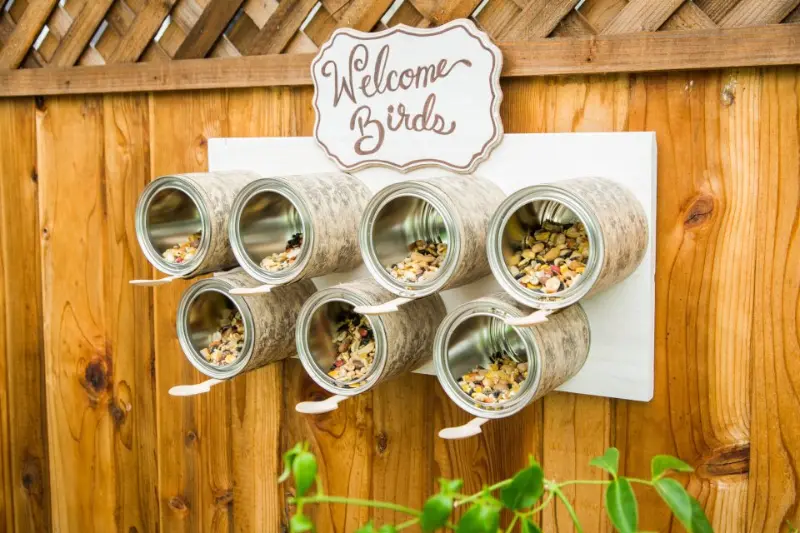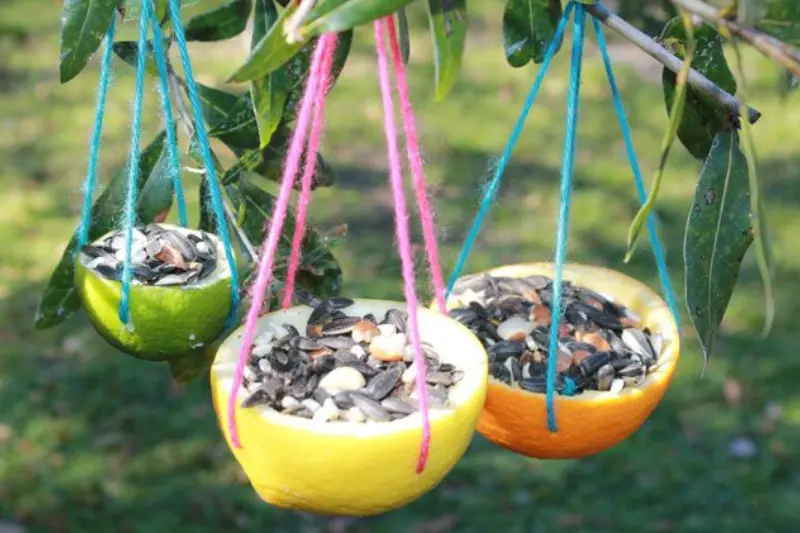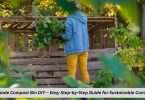Introduction
Have you ever looked at your trash and thought it could be turned into something useful? If yes, then you’ll enjoy this idea. Making DIY bird feeders from waste materials is a fun and easy way to reuse everyday items while helping the birds around you. Instead of throwing away things like plastic bottles, tin cans, or toilet rolls, you can turn them into creative bird feeders right at home.
This activity is great for both kids and adults. It teaches us how to care for nature, reduce waste, and support local wildlife. Plus, it’s budget-friendly and doesn’t require any special tools or materials. In this blog post, you’ll learn how to make simple bird feeders using things you already have at home. Let’s get started and give our feathered friends a treat — while doing something good for the planet.
What is “DIY bird feeders from waste materials”?

DIY bird feeders from waste materials are homemade bird feeders made by reusing items that would normally be thrown away. Instead of buying new feeders from the store, you can create your own using common household waste like plastic bottles, tin cans, cardboard, or old cups.
DIY stands for “Do It Yourself,” which means you make it on your own, often in a fun and creative way. These types of bird feeders are not only useful for feeding birds, but they also help reduce waste and encourage recycling. They’re a great example of how small actions can make a big difference for the environment.
By turning trash into something helpful, you’re giving waste a second life and creating a safe space for birds to eat, especially during times when food is hard to find.
You May Also Like It:
How to Protect Trees During Storms – Essential Tips for Tree Safety
How to Spot Overwatering vs Underwatering: Key Plant Care Signs
Plant Nutrition & Fertilizer Guide | Essential Tips for Healthy Growth
Why is This Important?
Making DIY bird feeders from waste materials may seem like a small act, but it has a big impact. It supports the environment, helps local wildlife, and teaches us valuable lessons. Here’s why this simple project really matters:
Helps the Environment
Reduces Household Waste
Instead of adding more trash to landfills, you’re giving items a second life. This cuts down on pollution and saves resources.
Promotes Recycling and Upcycling
Making bird feeders encourages creative reuse. It shows how we can turn “waste” into something useful.
Lowers Carbon Footprint
By reusing materials at home, we reduce the need for manufacturing and transport. This helps lower greenhouse gas emissions.
Supports Local Wildlife
Provides Food for Birds
In hot summers or urban areas, natural food sources can be limited. DIY feeders offer a steady food supply for birds.
Encourages Biodiversity
Feeding birds in your area attracts different species. This helps maintain a balanced and healthy local ecosystem.
Offers Shelter and Resting Spots
Bird feeders can also act as safe places for birds to rest. Especially helpful in busy or noisy neighborhoods.
Encourages Learning and Creativity
Teaches Kids About Nature
This activity helps children understand birds, seasons, and the importance of caring for animals. It connects them with the natural world.
Builds Eco-Friendly Habits
Making useful items from waste encourages sustainable thinking. It helps build habits that are better for the planet.
Sparks Imagination and Problem-Solving
Choosing materials and designing feeders improves creative thinking. It’s a fun and hands-on way to learn at any age.
Step-by-Step Guide: DIY Bird Feeders from Waste Materials

Making your own bird feeder is simple and doesn’t require fancy tools. Just follow these steps using materials you’d normally throw away.
Step 1: Gather Waste Materials
Look around your home for clean waste items you can reuse. Good options include:
- Empty plastic bottles
- Tin cans
- Milk cartons
- Toilet paper rolls
- Cardboard pieces
- Old mugs or cups
Make sure all items are clean and safe to handle.
Step 2: Choose a Bird Feeder Design
Decide which type of feeder you’d like to make. A few easy ideas are:
- A bottle feeder using a plastic bottle and wooden spoons
- A toilet roll feeder coated with peanut butter and birdseed
- A tin can feeder that hangs sideways like a swing
Choose one that fits the materials you have.
Step 3: Cut and Shape Your Materials
Use scissors or a cutter carefully (with adult help if needed). For example:
- Cut holes in the sides of a bottle for inserting spoons or sticks
- Remove sharp edges from tin cans and punch holes for string
- Make a small window in a carton so birds can reach the food
Always handle tools safely and work on a flat surface.
Step 4: Add Food for the Birds
Once your feeder is shaped, it’s time to fill it:
- Use birdseed, crushed peanuts, sunflower seeds, or dry oats
- Spread peanut butter on toilet rolls before rolling in birdseed
- Avoid salty or sugary foods — they’re not good for birds
Keep it natural and healthy for your feathered visitors.
Step 5: Hang or Place Your Feeder
Use string, wire, or twine to hang the feeder in a safe spot:
- Choose a shady, quiet area like a tree branch or balcony
- Keep it out of reach of cats or other predators
- Make sure it’s stable so birds feel safe while feeding
Watch from a distance as the birds come to explore.
Step 6: Keep It Clean and Refill Regularly
Bird feeders need a little care to stay safe and useful:
- Clean your feeder every week with mild soap and water
- Remove old or wet seeds to avoid mold
- Refill it often, especially in early morning or late afternoon
This keeps birds healthy and encourages them to return.
Advantages and Disadvantages of DIY Bird Feeders from Waste Materials
Creating bird feeders using household waste is a rewarding activity, but like everything, it comes with both benefits and some challenges. Let’s take a look at both sides:
| Advantages | Disadvantages |
| Eco-Friendly Reusing waste materials helps reduce pollution and keeps items out of landfills. | Less Durable Homemade feeders made from soft materials like cardboard may break down quickly in bad weather. |
| Low-Cost Project Most materials are already available at home, so you don’t need to spend money. | Needs Regular Cleaning Without proper maintenance, feeders can grow mold or spread disease among birds. |
| Educational for All Ages This project teaches children and adults about recycling, nature, and bird behavior. | May Not Be Pest-Proof DIY feeders can attract squirrels, ants, or other pests if not properly secured or designed. |
| Customizable and Creative You can design feeders in any shape or size, using your imagination and personal style. | Limited Size and Stability Some DIY feeders may not hold much birdseed or stay balanced, especially in windy conditions. |
| Fun Family Activity It’s a great hands-on project for families to enjoy together, especially with children. | Not Always Weatherproof Some waste materials can’t handle rain or extreme heat, reducing the feeder’s lifespan. |
You May Also Like It:
Common Tree Diseases and Effective Treatment Methods – Tree Care Guide
Best Time to Trim Trees – Seasonal Guide for Healthy Growth
How to Keep Indoor Plants Healthy | Essential Tips for Thriving Houseplants
Common FAQs About DIY Bird Feeders from Waste Materials
What kind of waste materials can I use to make bird feeders?
You can use plastic bottles, tin cans, empty cartons, toilet paper rolls, old cups, and cardboard. Just make sure they are clean and safe for birds.
How do I keep the bird feeder clean?
Wash it regularly with warm water and mild soap. Remove old seeds and dry the feeder before refilling to keep birds healthy.
What food should I put in the bird feeder?
Use birdseed mixes, sunflower seeds, oats, or crushed peanuts. Avoid salty, sugary, or processed foods as they can harm birds.
Where should I hang my DIY bird feeder?
Pick a quiet, shady spot like a tree branch or balcony. Make sure it’s away from cats or other predators and easy for birds to reach.
Will making DIY bird feeders attract pests?
Sometimes squirrels or ants might come. To avoid this, place the feeder away from places pests like to hide and keep it clean.
Can kids make these bird feeders?
Yes! DIY bird feeders are a fun and safe project for kids, but adults should help with cutting and hanging to keep everyone safe.
How often should I refill the bird feeder?
Refill it when the seeds run low, especially in the morning or late afternoon when birds are most active.
Conclusion
Making DIY bird feeders from waste materials is a fun, easy, and eco-friendly way to help birds while using things you already have at home. It’s good for the environment, teaches us to recycle, and brings nature closer to us. Whether you’re doing it with kids or on your own, this small project can make a big difference for local birds. So grab some old bottles or cans, get creative, and enjoy watching the birds visit your homemade feeder.
Bonus Points
- Use Natural Paints and Decorations: If you want to decorate your feeder, choose non-toxic, bird-safe paints and natural decorations like pinecones or leaves.
- Add Water Sources: Along with feeders, placing a small shallow dish of water nearby helps birds stay hydrated.
- Choose Native Seeds: Use seeds that are natural to your area to attract local bird species and support their diet.
- Make Different Types of Feeders: Try creating multiple feeders with different designs to attract a variety of birds.
- Place Feeders at Different Heights: Hanging feeders at various levels can help different bird species find food safely.
- Keep a Bird Journal: Note the types of birds that visit your feeder — it’s a fun way to learn more about local wildlife.
You May Also Like It:
Tree Pruning Tips for Beginners – Easy Guide to Healthier Trees
Why Your Plant Leaves Are Turning Yellow | Common Causes & Easy Fixes
Natural Remedies for Plant Pests | Eco-Friendly Pest Control Tips 2025
How to Care for Trees in Your Backyard – Tree Maintenance Tips 2025




